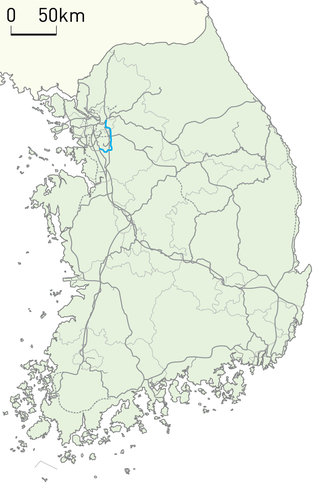Top Qs
Timeline
Chat
Perspective
Bundang Line
Subway line in South Korea From Wikipedia, the free encyclopedia
Remove ads
The Bundang Line or Seoul Metropolitan Subway Bundang Line (Sudogwon Jeoncheol Bundangseon Korean: 수도권 전철 분당선) was a commuter rail line of the Seoul Metropolitan Subway in the Seoul Capital Area operated by Korail. Also it refers physical railway track from Wangsimni to Suwon which is designated by MOLIT. The name 'Bundang Line' refers to the fact that the line was originally constructed for the new planned town of Bundang. The line service started in central eastern Seoul at Cheongnyangni, crossing Gangnam District and connecting the cities of Seongnam and Yongin, and terminates at Suwon Station. While the track 'Bundang Line' designated by MOLIT is from Wangsimni to Suwon.[1]
You can help expand this article with text translated from the corresponding article in Korean. (September 2022) Click [show] for important translation instructions.
|
Remove ads
Service
Summarize
Perspective
Trains ran every 4~5 minutes during rush hours and every 7~8 minutes during off peak hours between Wangsimni and Jukjeon. Trains run at half the frequency between Jukjeon and Suwon, except during rush hours.
Most northbound trains terminated at Wangsimni. Some northbound trains continued one stop to Cheongnyangni, and the last few trains in the evening from Suwon terminated at Jukjeon. Half of all southbound trains head to Suwon, and the other half short-turn at Jukjeon. Express train service stopped at all stops between Wangsimni and Jukjeon, and thereafter at Giheung, Mangpo, Suwon City Hall and Suwon. The express service only operated during rush hours on weekdays.
Remove ads
History
| 1994 | September 1 | The Bundang Line is officially opened from Suseo to Ori. |
| 2003 | September 3 | The line is extended northward from Suseo to Seolleung. |
| 2004 | January 16 | Imae Station opens as an in-fill station. |
| September 24 | Guryong Station opens as an in-fill station. | |
| November 26 | A temporary Bojeong Station opens near the Bundang Line Train Depot, south of Ori. | |
| 2007 | December 24 | Jukjeon Station opens as an in-fill station. |
| 2011 | December 28 | The line is extended southward from Jukjeon to Giheung. The temporary Bojeong Station is replaced with a new underground station, also called Bojeong.[2] |
| 2012 | October 6 | The line is extended northward from Seolleung to Wangsimni. |
| December 1 | The line is extended southward from Giheung to Mangpo. | |
| 2013 | November 30 | The line is extended westward from Mangpo to Suwon was opened, allowing for connections to Line 1. Express service was launched. |
| 2018 | December 31 | The line is extended northeastward to Cheongnyangni station, allowing for connections to the Gyeongchun Line and regional rail services. |
| 2020 | September 12 | The service was extended westward from Suwon to Oido, merging with the Suin Line, forming the Suin–Bundang Line. Trains will run from Cheongnyangni station or Wangsimni station to Jukjeon station, Gosaek station, or Incheon station. |
Remove ads
Stations
Summarize
Perspective
The negative sign is only a convention for distance notation from Wangsimni Station, the terminus of most services.
Rolling Stock
The Bundang Line used 43 Korail Class 351000 trains. Earlier trains were originally the same models used on Line 4, as they were all originally classified as Class 2000 trains. First generation trains (351-01~351-22) were introduced since the line's opening, second generation trains (351-23~351-28) were introduced when the Bundang Line was extended from Suseo to Seolleung in 2003, and third generation trains (351-29~351-43) were introduced as more extensions open.
Remove ads
References
See also
Wikiwand - on
Seamless Wikipedia browsing. On steroids.
Remove ads


